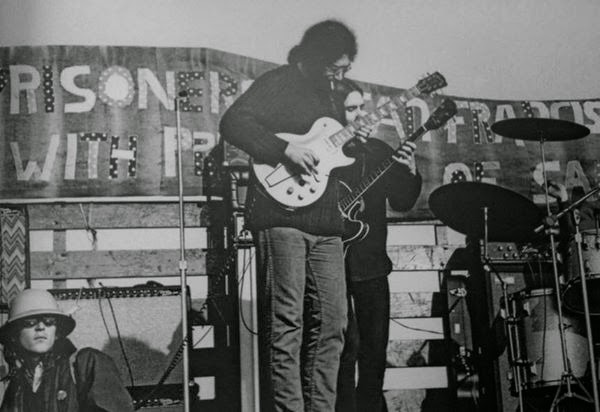For your literary and historical pleasure, Enthusiasts, TotD presents a reading list designed to edify, educate, and entertain. First up because it deserves to be first is an always-welcome new post on Hooterollin’ Around that details the Dead’s whereabouts in the first half of 1968. Adventures! Business ownership! Flatbed trucks! A guy named Toody! This one’s got everything, ladies and gents.
Well, almost everything. At one point, Corry–he writes the damn thing, you know Corry, he’s a good egg–relates the story of Garcia and Bobby (with Bobby on bass!) playing a protest gig outside of San Quentin; he alludes to a picture of the event, but does not post it.

I helped. I am a historian now. I have credibility.
Stop it.
So, yeah: in 1968, rock bands were allowed to set up outside maximum-security prisons and jam. This was a regular occurrence; it was in protest of the death penalty in California. Enthusiasts will note that there is now no death penalty in California. Ipso facto: the Grateful Dead brought down the death penalty via the power of rock and roll. I would like to present this opinion as an academic paper at next year’s Dead Scholars conference.
This picture can also be used to give paper cuts to, or jam up the ass of, any of those little ticks that say, “The Dead weren’t a political band, maaaaaaaan.”
(Can you imagine if a band tried this bullshit today? Like if Run The Jewels set up outside Leavenworth? The cops would shoot them in their faces before the first chorus, and then the gold-plated tin dictator would cheer. “They were disrespecting our jails, which are just like the troops. Cops did their job! Flag!” For all the talk about The Man back in the old days, you were allowed to get away with an astonishing amount of foolishness.)
This next one isn’t so much an article as it is a picture, so I’ll just show it to you and cut out the middle man:

That is a Slingerland Songster, Enthusiasts, and that–not the “log” guitar made by Les Paul–was the first commercially-available solidbody electric guitar. It kind of looks like Peanut, Garcia’s short-lived experimental Alembic from ’71, and there is another point of comparison. Like Garcia’s guitars, this sucker was pricey. Slingerland sold the axe, a hard case, and a little amplifier for $150 in 1939. Which means it cost $2,500. Unsurprisingly, the Songster failed to catch on.
Finally: the story of the monkey and the engineer, Australian South African style. Trust me.





There hasn’t been an execution in a long time, but, regrettably, California does still have the death penalty. But I am sure the boys gave it a good try!
Thanks for the kind words.
I would note that Weir played bass at the San Quentin thing, and never seems to have played bass again, in public or private. Maybe that ended the Death Penalty?
Guitar in the first pic is 52-53 Less Paul? I own a ’52, one of the first 40 made.
Retract, Sir! Jack was a South African baboon. Australian baboons would never work for the railways.
Dammit. The site’s from Australia, and I got all confused.
It’s good to sight
A corrected cite
From an Oz-based site.